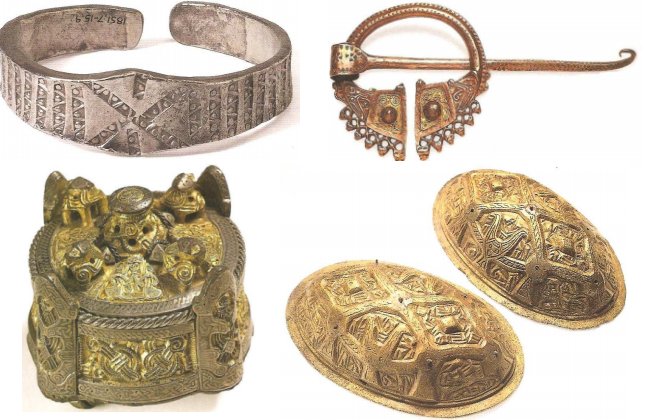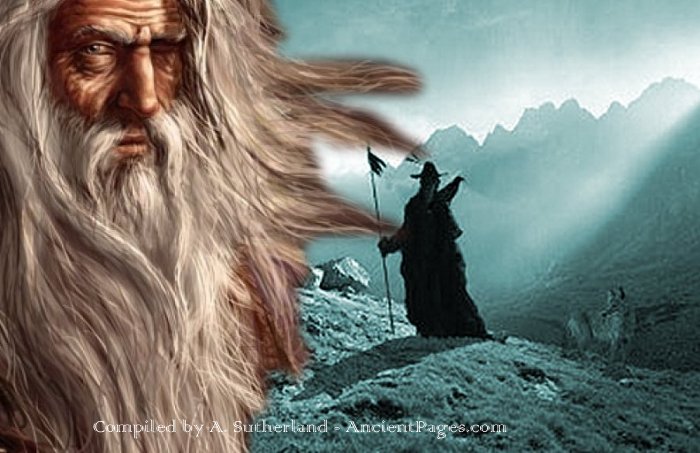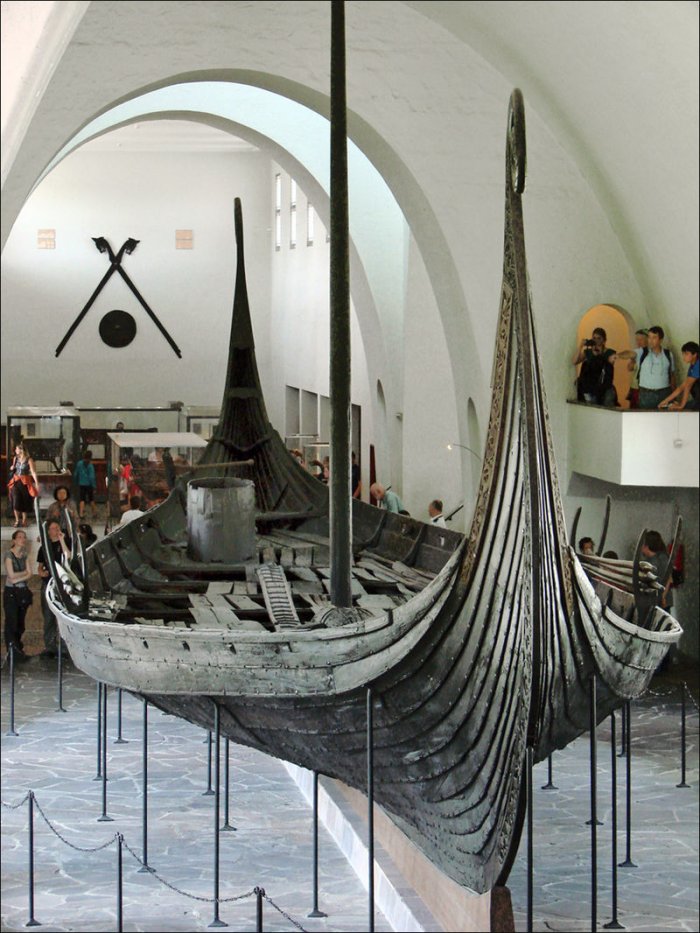Vikings: Facts And History About The Tough Norse Seafaring People
A. Sutherland - AncientPages.com - Famous as the Lords of the Ocean, the Vikings had their homeland in the Nordic regions of Europe known today as Scandinavia.
Many associate Vikings with brutal robbers and people were terrified when they spotted a Viking ship approaching.
It’s true that Vikings were tough warriors who conquered many territories, but these people were also members of an amazing ancient culture that many are unfamiliar with. The legacy and traditions of the Vikings are still alive today, not only in Scandinavia but also in countries they visited.
In this article, we examine facts and history about the Vikings - the Norse seafaring people.
Viking culture is today associated with poetry, woodcarving, and storytelling, colorful shields, berserkers, longships, Valhalla, the one-eyed god Odin and men drinking out of skulls or dying with a sword in hand.
Their culture was rich and left traces in almost every area of social life.
Vikings were warriors, traders, farmers or craftsmen and shared common features such as house forms, jewelry, tools, and everyday equipment. They lived in the Age of the Vikings, from around 800 AD to 1050 AD.
Vikings had a pantheon of gods and a non-standardized alphabet, called runes. They became also famous for their sailing techniques, weapons, and a code of conduct.
Viking Society
In the Viking Age society, people were divided into three main classes; the noblemen called Jarls, the middle class, free Vikings (farmers, craftsmen, tradesmen) called Karls, and the slaves - called Thralls, who had many tasks. Kings, princes and nobles, high officials, military leaders were above them.
A household in Viking times could be very large, for one family, relatives, and employees. Houses were built of wood, stone, and peat, usually consisting of one long enclosed space with a fireplace in the middle, with areas for cooking, eating, sleeping and an indoor relaxation. Vikings enjoyed playing a variety of board games during long, cold winter evenings. One of the most popular board games was the Hnefatafl.
People cultivated rye, barley, oats, wheat, cabbage, peas, beans, and root vegetables and used the Radl (primitive wooden plow) which prepared the ground for sowing, spades, wooden forks, and flails. Grain and hay were cut with an iron sickle and knives were used to cut leaves. Vikings’ farm animals included pigs, sheep, goats, cattle, horses, geese, and chickens.
The family was very important to the Vikings, who kept family possessions and valuables in wooden chests, locked with padlocks.
Women In Viking Society
The Viking woman had a respected position in society. She was considered an equal to her husband in almost everything. When the men were out on trips women took care of the household and the defense of the estate, if necessary.
Evidence suggests that there were women warriors in the Viking era (although very rarely). Some experts suggest that Sela, Lathgertha, Hertha, and Visna may well have been the names of warrior women.
Viking Culture And Art
The Vikings introduced excellent ceramics, distinctive styles of dress with a variety of patterns and ornaments, and hairstyle.
Vikings wore clothes similar to those of people in England, Scotland, and Wales at that time. Men wore tunics and trousers. Women wore long dresses, with a kind of long apron. Clothes were made from wool, linen, and animal skins.
Warriors had helmets and their weapons were - a short sword and a round shield.
Viking Religion
Vikings believed in two main families (“clans”) of gods: the Aesir (sky gods, or gods and goddesses of humankind) and the Vanir (earth Gods, or gods and goddesses of nature). They also believed in elves, dwarves, trolls, and intelligent, powerful animals, like Jormungand, the sea-serpent, and Fenrir.
The Tree of Life, Yggdrasil played an important role in Norse myths and legends. They also believed in Valhalla, the home for warriors who died gloriously in battle. According to Viking beliefs, the warriors who died in battle, were abducted by Valkyrie, virgins in paradise, and taken by them to Valhalla, where they could feast among the gods.
The most important god was Odin (also known as Wotan). He was the god of war, magic, and justice. Thor was a warrior god and god of thunder and lightning. Freyr with his sister, Freya, were gods of fertility. Behind them further was a whole pantheon of gods of Asgard, home of the gods.
The end of the world in Vikings’ beliefs was Ragnarok (twilight of the gods), where a final battle will take place between good and evil, which in turn would result in the advent of a new era.
Viking Alphabet And Rune Stones
The Vikings had their own simple alphabet, Futhark – runes. Runic inscriptions have been found where Vikings lived. Runes were written on wood, bone, metal, and stones. The most amazing examples of runic inscriptions are free-standing, vertical rocks.
Depending on the geographical location, the sign of the Futhark could vary.
The Rök Stone is the longest runic inscription ever discovered.
The rune stones of the Viking period were erected in memory and honor of the dead – mostly powerful people and their honorable deeds but also informed about the sad fates of ordinary people (men and women). Often mentioned are the deceased’s closest kin, position in society, a short description of his or her character, and the circumstances surrounding the death.
Rune stone (Sö 106) at Kungshållet at Kjula ridge. Elias Wessén and Harald Faith-Ell are filling the runes with paint. Their car on the road. The inscription says: "Alrik, Sigrid's son, raised the stone in memory of his father Spjut, who had been in the west, broken down and fought in townships. He knew all the journey's fortresses (?)". Source: Rune stone, Kungshållet, Kjula, Södermanland, Sweden
The Kjula Runestone - Rune stone, Kungshållet, Kjula, Södermanland, Sweden
Painted in bright colors, rune stones were intended to be visible by standing near roads or bridges, but they were not necessarily placed at the burial of the person they commemorated.
Around 250 rune stones are known from Viking Age Denmark after Harald Bluetooth erected the large Jelling Stone for his father, Gorm the Old, and his mother, Thyra, around 970. Most of the runestones in Denmark were raised in period c. 975-1025.
Most of the Scandinavian examples are from Sweden, where there are over 3000 inscriptions.
Code Of Conduct And Viking Law And Order
In the Viking period honor, family and lineage were crucially important, and society was bound together by traditions and norms. If these norms were broken, then an individual’s honor and society’s approval could be lost. Personal honor was achieved through particular attributes, such as courage, fellowship, cleverness, and generosity.
The Vikings attached great significance to the reputation that they left behind after death. If a person’s honor and reputation were intact, then his or her name would never be forgotten. The great Eddic poem Hávamál describes a large number of practical rules of conduct for everyday life. There are verses about wisdom, friendship, how to act as a guest, and how to behave at assemblies (“things”).
Viking society had a sophisticated government and the so-called 'Thing', Viking law and order system. It was the governing assembly made up of the community's free people both men, women, and handicapped. They gathered to make law, resolve disputes, and make decisions. The meeting place was called a thingstead.
Vikings preferred the ‘Thing’ instead of having disputes settled by duel or family feuds. All free men and women had the right to conduct revenge killings.
You could kill somebody in public without suffering serious consequences, because you were honest and did not hide your actions, and gave others the opportunity to react.
It was important to take responsibility for the murder and not run away, and to pay the fines. The same applied to kill somebody in a fight.
Vikings And Their Navigational Skills
The great merit of the Vikings was to perfect the art of navigation. They were skilled ancient seafarers and shipbuilders.
Their famous longships, with oars along almost the entire length of a boat) were light and narrow wooden boats with a shallow-draft hull designed for easy navigation in shallow waters and for speed, reaching 15 knots in good weather conditions. The longships were double-ended, so they could reverse direction without needing to turn around – a major advantage in a sea packed with concealed icebergs and sea ice.
Longships symbolized the power of the Vikings and were decorated with carved dragon heads that deterred enemies. Symbols were important to the Vikings.
The fleets, sailing to England, Scotland, France, and Ireland, contained hundreds of longships, mainly used as warships and their other ships called Knarrs (or knorrs in Old Norse), which were slower served as passenger and cargo ships.
Known as the lords of the oceans, the Vikings developed navigation to perfection, which in those days was very difficult. They carried portable wooden sundials which helped them on clear days and sunstones the so-called Alderney-like crystals could really have been used as an accurate optical sun compass as an aid to ancient navigation when the Sun was hidden by clouds or below the horizon.
Martial Skills Of Vikings
A wealthy Viking’s complete set of weapons was: a spear, one or two javelins, a wooden shield, a Danish ax, and a sword, “fire of Odin”.
Additionally, Glima - the martial arts system - was used by the Vikings. The word Glíma in Old Norse means glimpse or flash, which describes the system's techniques. Glima is in two categories - Combat Glima and Sport Glima.
Expeditions, Conquests And The End Of The Viking Age
The Vikings founded many cities and colonies, including Dublin and Normandy. Dublin was held as a major settlement for more than three centuries. Between the years 879 and 920 the Vikings colonized Iceland, which in turn became the springboard for Erik the Red's colonization of Greenland.
The Vikings even reached North America, and remains of a Viking settlement at L'Anse aux Meadows in Newfoundland have been carbon-dated to around the year 1000.
They had good armor, shields, and a plethora of weapons, including double-edged swords. The prestige as a man was manifest in the fine craftsmanship of his weapons, which were so much part of him, that they had personal names like “leg-biter” or “bone-crusher” or “golden-hilt”.
By the 1100s the Vikings were weakened by domestic unrest. At the same time, many other European countries were becoming stronger and more difficult targets. The Viking raids stopped at about 1100. Then, the majority of the Vikings converted to Christianity and became less warlike.
Written by – A. Sutherland AncientPages.com Staff Writer
Copyright © AncientPages.com All rights reserved. This material may not be published, broadcast, rewritten or redistributed in whole or part without the express written permission of AncientPages.com
Expand for referencesMore From Ancient Pages
-
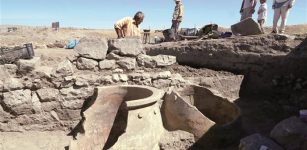 Huge Jars Unearthed In Kultepe, Turkey
Archaeology | Sep 27, 2015
Huge Jars Unearthed In Kultepe, Turkey
Archaeology | Sep 27, 2015 -
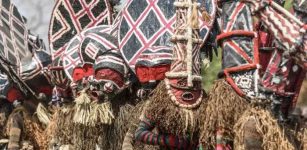 Famed Makishi Dancers And Likumbi Lya Mize Ceremony In Zambia – Much More Than Just A Festival
Ancient Traditions And Customs | Aug 6, 2019
Famed Makishi Dancers And Likumbi Lya Mize Ceremony In Zambia – Much More Than Just A Festival
Ancient Traditions And Customs | Aug 6, 2019 -
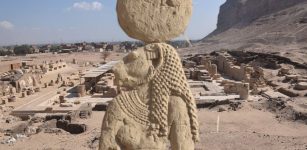 Is An Ancient Temple Dedicated To The Lioness Goddess Repit Hidden In The Cliffs Of Athribis?
Archaeology | Dec 10, 2024
Is An Ancient Temple Dedicated To The Lioness Goddess Repit Hidden In The Cliffs Of Athribis?
Archaeology | Dec 10, 2024 -
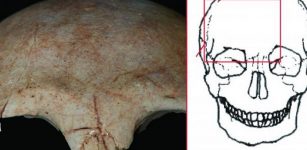 Ancient Warfare And Continuous Rise In Global Population – Is There A Connection?
Archaeology | Sep 13, 2021
Ancient Warfare And Continuous Rise In Global Population – Is There A Connection?
Archaeology | Sep 13, 2021 -
 Three Roman Shipwrecks Discovered Off Tunisian Coast – One Is 2,000-Year-Old
Archaeology | Jun 9, 2023
Three Roman Shipwrecks Discovered Off Tunisian Coast – One Is 2,000-Year-Old
Archaeology | Jun 9, 2023 -
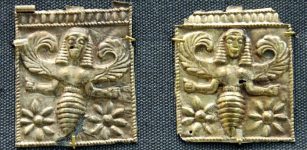 Bees – Embodiment Of Human Soul, Divine Messengers Symbolizing Invisible Bridge Connecting Life And Death
Featured Stories | Jul 26, 2023
Bees – Embodiment Of Human Soul, Divine Messengers Symbolizing Invisible Bridge Connecting Life And Death
Featured Stories | Jul 26, 2023 -
 Evidence Of Rare Roman-Celtic Temple Near Lancaster Castle
Archaeology | Mar 9, 2023
Evidence Of Rare Roman-Celtic Temple Near Lancaster Castle
Archaeology | Mar 9, 2023 -
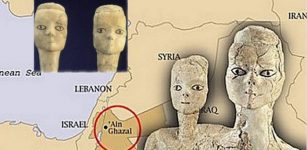 Stone Age Statues Were Taken To Britain For Restoration In 1990 – Never Returned Home To Jordan
News | Apr 6, 2021
Stone Age Statues Were Taken To Britain For Restoration In 1990 – Never Returned Home To Jordan
News | Apr 6, 2021 -
 Strange Case Of The Italian Doppelganger – Collision Of Parallel Timelines? Part 2
Featured Stories | Oct 16, 2019
Strange Case Of The Italian Doppelganger – Collision Of Parallel Timelines? Part 2
Featured Stories | Oct 16, 2019 -
 Tokoloshe: Demonic Creature That Feeds On Spiritual Energy Of Its Victims
Featured Stories | Sep 9, 2020
Tokoloshe: Demonic Creature That Feeds On Spiritual Energy Of Its Victims
Featured Stories | Sep 9, 2020 -
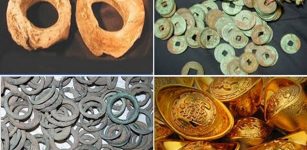 Our Lives Have Always Been Manipulated By Money – Part 3
Featured Stories | Jun 8, 2022
Our Lives Have Always Been Manipulated By Money – Part 3
Featured Stories | Jun 8, 2022 -
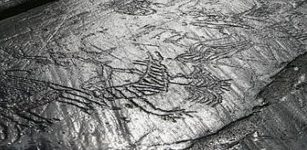 Ausevik Rock Art: Real And Mythical World Of Stone Age People Of Norway
Civilizations | Oct 2, 2018
Ausevik Rock Art: Real And Mythical World Of Stone Age People Of Norway
Civilizations | Oct 2, 2018 -
 Secret Ancient Knowledge Of Portals Leading To Unknown Realms – Mysteries Of The Past And Present – Part 2
Ancient Mysteries | Dec 7, 2021
Secret Ancient Knowledge Of Portals Leading To Unknown Realms – Mysteries Of The Past And Present – Part 2
Ancient Mysteries | Dec 7, 2021 -
 Weapons Of Ancient Aztec Warriors Of Mesoamerica
Featured Stories | Mar 23, 2017
Weapons Of Ancient Aztec Warriors Of Mesoamerica
Featured Stories | Mar 23, 2017 -
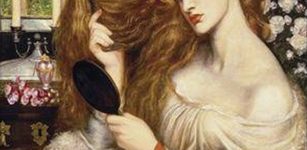 Lilith – Beautiful Demonic And Brave Symbol Of Equality And Adam’s First Wife Who Refused Subordination
Biblical Mysteries | May 24, 2020
Lilith – Beautiful Demonic And Brave Symbol Of Equality And Adam’s First Wife Who Refused Subordination
Biblical Mysteries | May 24, 2020 -
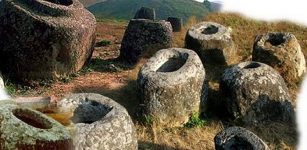 Mysterious Gigantic Jars Of Unknown Origin Discovered Worldwide
Artifacts | Dec 27, 2018
Mysterious Gigantic Jars Of Unknown Origin Discovered Worldwide
Artifacts | Dec 27, 2018 -
 Agriculture In North America Led To Changes In Age-Independent Mortality
Archaeology | Jan 24, 2023
Agriculture In North America Led To Changes In Age-Independent Mortality
Archaeology | Jan 24, 2023 -
 Greek Discovery Of Stone Tools In Megalopolis Area Pushes Back Greece’s Archaeological Record Up To 250,000 Years
Archaeology | Jun 2, 2023
Greek Discovery Of Stone Tools In Megalopolis Area Pushes Back Greece’s Archaeological Record Up To 250,000 Years
Archaeology | Jun 2, 2023 -
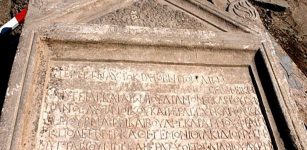 Third-Century Inscription Related To Dionysus Cult – Discovered
Archaeology | Jul 16, 2019
Third-Century Inscription Related To Dionysus Cult – Discovered
Archaeology | Jul 16, 2019 -
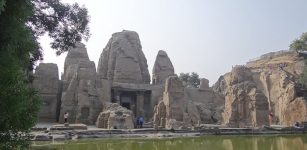 Masroor Temples – India’s Marvelous Ancient Cave Temples
Featured Stories | Jan 23, 2016
Masroor Temples – India’s Marvelous Ancient Cave Temples
Featured Stories | Jan 23, 2016



